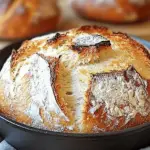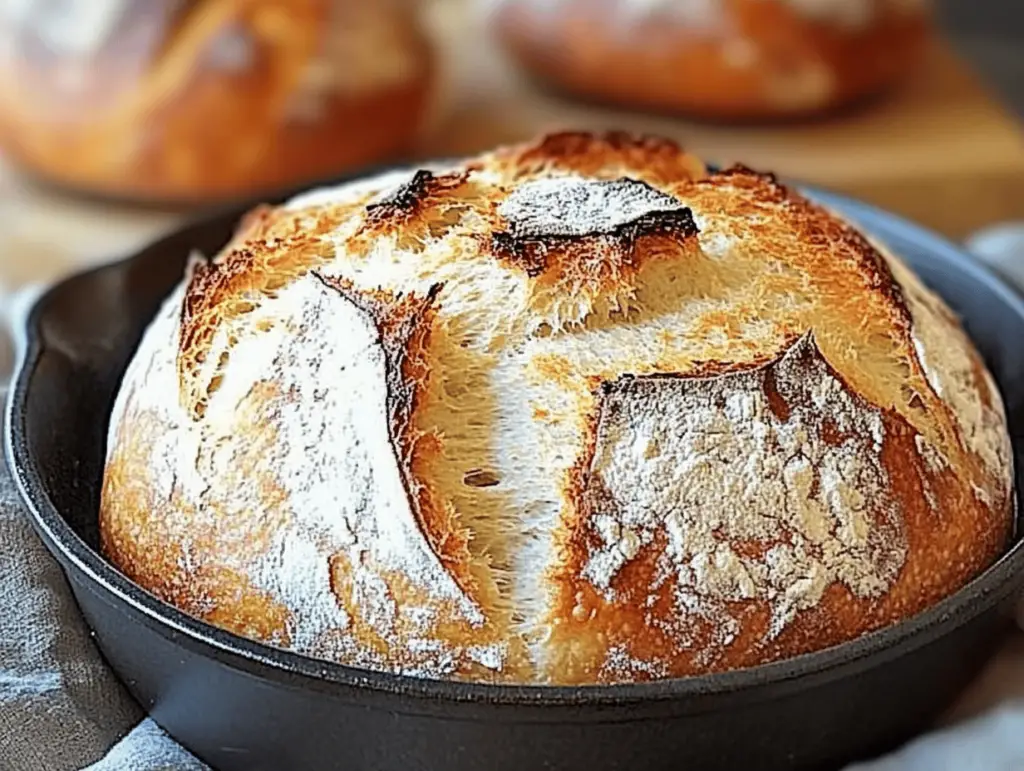There’s something magical about the aroma of freshly baked bread wafting through your home. The simple act of making your own bread can transform an ordinary day into a memorable experience. Homemade bread not only fills your kitchen with enticing scents but also provides a sense of accomplishment and satisfaction. Whether it’s for sandwiches, as a side to your favorite soup, or simply enjoyed warm with butter, homemade bread is a culinary staple that never goes out of style.
This article delves into the delightful world of homemade bread, guiding you through the process step-by-step. You’ll not only learn how to bake your own loaf from scratch but also uncover tips and tricks to ensure your bread turns out perfectly every time. Get ready to embrace the joys of baking and discover why this simple recipe is worth adding to your cooking repertoire!
Understanding the Recipe
Baking bread is an age-old tradition that spans cultures and generations. The art of bread-making has been celebrated in various forms, from rustic sourdoughs to festive challahs. This particular recipe is a straightforward approach that yields a soft, delicious loaf perfect for all occasions. It evokes the warmth and comfort of home, often reminding us of family gatherings around the dinner table.
Growing up, many of us associated the smell of fresh bread with our loved ones in the kitchen, preparing meals for special occasions or simple family dinners. This comforting connection makes baking your own bread not only a culinary task but also a nostalgic journey.
This recipe stands out due to its simplicity and quick preparation time. With just four main ingredients, it is incredibly accessible for both novice and experienced bakers. By the end of this article, you will learn how to create your own delicious homemade bread that you and your family will love!
Ingredient Breakdown
To make the perfect loaf of homemade bread, you’ll need the following ingredients:
- 1 cup warm water (370 ml): The warm water activates the yeast, which is crucial for the rising process.
- 2 tbsp dry yeast (10 g): This is the leavening agent that helps the bread rise and gives it a light texture.
- 4 cups flour (500 g): All-purpose flour is typically used, providing structure and chewiness to the bread.
- 1 tsp salt: Salt enhances the flavor of the bread and controls the fermentation of the yeast.
Using high-quality ingredients is essential. Consider organic flour and fresh yeast for the best results. If you have dietary restrictions, alternatives include using gluten-free flour blends or incorporating whole wheat flour for a healthier option. While this recipe is straightforward, these substitutions can add unique flavors and textures to your bread.
Step-by-Step Instructions
Follow these easy steps to create your own homemade bread:
- Preheat Oven: Begin by preheating your oven to 375°F (190°C).
- Mix Ingredients: In a bowl, combine 1 cup of warm water (370 ml) with 2 tablespoons of dry yeast (10 g). Allow it to sit for about 5 minutes until frothy, indicating the yeast is active. Next, add 4 cups of flour (500 g) and 1 teaspoon of salt to the mixture, stirring until a soft dough forms.
- Knead: Turn the dough out onto a floured surface. Knead the dough for approximately 5-7 minutes, until it becomes smooth and elastic. If it’s too sticky, sprinkle a little more flour as needed.
- Rise: Place the kneaded dough in a greased bowl, cover it with a clean cloth, and let it rise in a warm spot for about 1 hour, or until it has doubled in size.
- Shape: Once risen, punch down the dough to remove excess air. On a lightly floured surface, shape the dough into a loaf and place it on a greased baking sheet.
- Second Rise: Cover the shaped loaf again and let it rise for an additional 30 minutes while your oven finishes preheating.
- Bake: Bake the loaf in the preheated oven for about 25-30 minutes, or until it’s golden brown and sounds hollow when tapped.
- Cool & Serve: Allow the bread to cool on a wire rack for at least 10 minutes before slicing. Enjoy your fresh bread as is, or toast it for an even more delightful experience!
Variations and Customizations
Baking is all about creativity! Here are some ways to customize your homemade bread recipe to suit your personal taste or dietary needs:
- Herb-Infused Bread: Add 1-2 tablespoons of your favorite dried herbs (like rosemary or thyme) to the flour for a flavorful twist.
- Whole Grain Bread: Substitute half or all of the all-purpose flour with whole wheat flour for a more nutritious loaf.
- Sweet Or Savory Add-Ins: Consider adding 1 cup of raisins or chopped nuts for a sweet variety, or shredded cheese for a savory touch.
- Flatbreads: Shape the dough into flatbreads instead of a loaf for a quicker baking time; perfect for dipping or as a side!
- Gluten-Free Option: Swap the all-purpose flour with a gluten-free flour blend, ensuring you add a binder like xanthan gum to maintain the texture.
Serving Suggestions
Your freshly baked bread can be served in so many delightful ways:
- Garnishes: Brush the crust with melted butter or olive oil just after baking for added flavor.
- Sides: Serve it warm alongside soups, salads, or as a base for sandwiches filled with turkey or hearty veggies.
- Beverages: Pair with a crisp white wine or hearty ale for an enjoyable meal experience.
- Occasions: This homemade bread is perfect for family dinners, casual brunches, or festive gatherings. It’s an excellent addition to holiday meals or barbeques.
Tips for Success
To ensure your homemade bread turns out perfectly every time, keep these tips in mind:
- Always check the expiration date on your yeast; expired yeast may not activate properly.
- For the perfect rise, place your dough in a warm area, away from drafts.
- If kneading by hand, be patient; the dough should become smooth and elastic.
- For leftovers, store the bread in a sealed bag at room temperature for up to 3 days, or freeze for up to 3 months. To freeze, wrap the loaf tightly in plastic wrap, then in aluminum foil.
FAQs
Can I use instant yeast instead of dry yeast?
Yes, you can substitute instant yeast in a 1:1 ratio. No need to activate it in warm water; simply mix it with the dry ingredients.
What can I use if I’m allergic to gluten?
Consider using a gluten-free flour blend designed for baking, but be sure to check the packaging for specific instructions as some blends might require additional ingredients.
How do I know when my bread is done baking?
You can check if it’s done by tapping the bottom of the loaf; if it sounds hollow, it’s ready. Additionally, the top should be golden brown.
Can I make this bread without salt?
While you can omit salt, it does impact flavor and the yeast’s activity. It’s recommended to keep at least a small amount for best results.
How do I store my leftovers?
Store any leftover bread in a sealed bag at room temperature for a couple of days or freeze it for longer storage. To refresh, warm it briefly in the oven before serving.
Conclusion
Making your own homemade bread is a rewarding and enjoyable experience that brings comfort and flavor to your table. This recipe not only provides a delicious and wholesome loaf but also invites you into the therapeutic process of baking. With minimal ingredients and straightforward steps, you can create something truly special.
So, roll up your sleeves and give this recipe a try! Share your baking experience with friends and family, and don’t hesitate to explore various customizations. Happy baking!
Print
Homemade Bread
Description
Bake delicious homemade bread with just four ingredients! Enjoy the warm, comforting aroma and a perfect loaf for any meal or occasion.
Ingredients
- 1 cup warm water (370 ml): The warm water activates the yeast, which is crucial for the rising process.
- 2 tbsp dry yeast (10 g): This is the leavening agent that helps the bread rise and gives it a light texture.
- 4 cups flour (500 g): All-purpose flour is typically used, providing structure and chewiness to the bread.
- 1 tsp salt: Salt enhances the flavor of the bread and controls the fermentation of the yeast.
Instructions
- Preheat Oven: Begin by preheating your oven to 375°F (190°C).
- Mix Ingredients: In a bowl, combine 1 cup of warm water (370 ml) with 2 tablespoons of dry yeast (10 g). Allow it to sit for about 5 minutes until frothy, indicating the yeast is active. Next, add 4 cups of flour (500 g) and 1 teaspoon of salt to the mixture, stirring until a soft dough forms.
- Knead: Turn the dough out onto a floured surface. Knead the dough for approximately 5-7 minutes, until it becomes smooth and elastic. If it’s too sticky, sprinkle a little more flour as needed.
- Rise: Place the kneaded dough in a greased bowl, cover it with a clean cloth, and let it rise in a warm spot for about 1 hour, or until it has doubled in size.
- Shape: Once risen, punch down the dough to remove excess air. On a lightly floured surface, shape the dough into a loaf and place it on a greased baking sheet.
- Second Rise: Cover the shaped loaf again and let it rise for an additional 30 minutes while your oven finishes preheating.
- Bake: Bake the loaf in the preheated oven for about 25-30 minutes, or until it’s golden brown and sounds hollow when tapped.
- Cool & Serve: Allow the bread to cool on a wire rack for at least 10 minutes before slicing. Enjoy your fresh bread as is, or toast it for an even more delightful experience!
